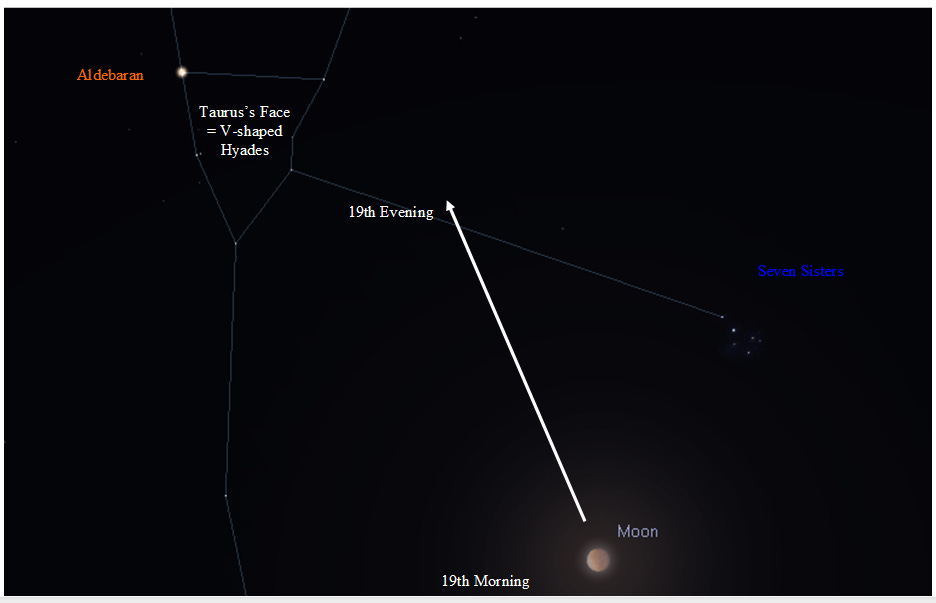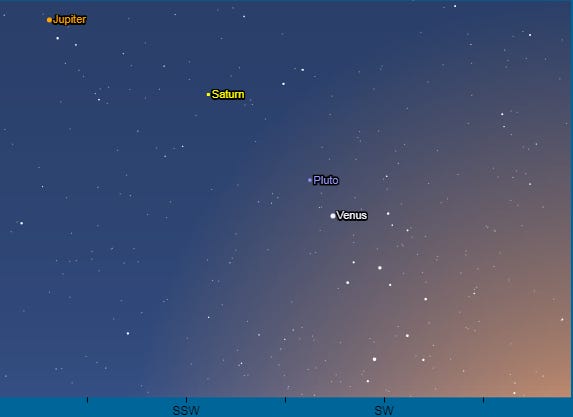The Galactic Times Newsletter #13 - November 16 - 30, 2021
White Dwarf Indigestion and a Barrier at the Galactic Center; Venus' Peak View; Dr. Fauci's Horoscope Sign?; 37.5% off Sale.
Cover Photo - Special Report - Dr. Fauci’s Sign?
In This Issue:
Cover Photo — The Astronomy of Ophiuchus
Improved and Revamped Homepage: www.galactictimes.com !
This Just In —Are White Dwarfs Solar System Post-Mortems?;
Knock, Knock. No, You Can’t Come In.Sky Planning Calendar —
* Moon-Gazing - The Longest Partial Eclipse;
* Observing—Plan-et — Venus’ Peak Show;
* Border Crossings (Cover Story) — Special Report - Dr. Fauci’s Sign?Astronomy in Everyday Life — You Think?
The Classroom Astronomer Newsletter Issue 13 Highlights
The Black Friday/End of Year/Holidays with 37.5% Discount Sale
Welcome to The Galactic Times Inbox Magazine!
So many things misunderstood….
We have any eclipse of the Moon this week, the shadow of the Earth on it, but so many people think that’s also the cause of the phases of the Moon.
So many people believing in the superstitions of astrology, and yet the Sun this week enters a “non-Zodiacal” constellation! Only it isn’t….
Headlines scream things that make you scratch your head, like those I found about a meteorite in Greenland. Who’d’a thunk it came from space??
In this issue (and also in the sister publication The Classroom Astronomer, we’ll explore a few of these things, and worry that all education sometimes seems for naught.
Meanwhile, see our revamped Home Page, with all past issue Tables of Contents and stories indexed by topic. You can also hear and find useful materials for education from our former podcast, now on this website (plus links to other Hermograph products and periodicals). Click here: http://www.thegalactictimes.com
Subscribe below or head to our (Free) Subscription page and Archive: https://thegalactictimes.substack.com, or just enter the box below…
If you are enjoying this twice-monthly newsletter, please support it by 1) using the link at the end to spread copies to your colleagues and friends and urge them to subscribe (why should you do all the emailing, right? We’re glad to do it!) and 2) help us pay the bills by taking advantage of our End of Year/Early Black Friday/ **37.5%** Discount Sale on Hermograph books and products.
If you are an educator, consider a subscription to The Classroom Astronomer, with a Deep Partial Eclipse reduced Eclipse Subscription Rate, now through November 19th, for only $22.10 per year!
Thanks!
Publisher — Dr. Larry Krumenaker Email: newsletter@thegalactictimes.com
This Just In—
* Are White Dwarfs Solar System Post-Mortems?
If you understand basic stellar evolution, you know that solar type stars become red giant stars when they grow old, eat their inner planets, then shrink into white dwarf stars. What nobody seemed to have thought about was…did everything about those inner planets just…disappear? Is there anything left? According to astronomers K. Putirka and S. Xu, you might find traces of them messing with the composition of the white dwarf stars left behind. Sort of a stellar indigestion.
In Nature Communications for Tuesday November 2nd, the astronomers analyzed the atmospheres of 23 nearby white dwarves. All are not identical. Some are apparently polluted with the constituents of their former rocky planets, with high amounts of Calcium, though all have low Silicon, high iron and high Magnesium. This may reflect the composition of the mantles of terrestrial planets gobbled up by the red giant phases of the stars.
* Knock, Knock. No, You Can’t Come In.
It is well known that cosmic rays fill interstellar space pretty uniformly. A large source of them is the galactic center. What Chinese scientist X. Huang and colleagues proposed in Nature Communications’ November 9th issue is that evidence may indicate that the Galactic Center may be a one-way zone. The amount of rays in the Core is less than outside, thus rays can be created and sent on their journey to the galaxy, but none can come back, or in from elsewhere. There is a barrier surrounding the galaxy’s center. Shades of old sci-fi!….
Sky Planning Calendar
Moon-Gazing
Moon passages by a star, planet or deep sky object are a good way to find a planet or other object if you’ve never located it before.
(adapted from Stellarium)
November 19 Full Moon. Also, in this pre-dawn, a Nearly Total Lunar Eclipse, (though beginning on the 18th for the US West Coast and the Pacific Rim). See below.
This evening you’ll find the Moon floating between the beautiful Seven Sisters (Pleiades) star cluster and ‘reddish’ Aldebaran, the bright eye star of the face of Taurus the Bull, first up of the major winter constellations. Aldebaran is in the V-shaped Hyades star cluster, one of, if not the, nearest star clusters to our Solar System.
November 21 The Moon is at apogee. We have the smallest moon of the month, a waning micro-gibbous moon.
November 22 The Moon is a soccer ball being kicked by the foot of Castor, the western half of the Gemini twins. Actually, Castor is quite athletic—he’s kicking two balls, one the Moon and the other a hive of fireflies, the binocular-visible M35 star cluster, between his foot and the Moon, though the Moon’s light may extinguish the dim lights of the bugs. You might wait a day or three after noting the location.
(Art from Stellarium)
November 23 The head of the other twin, Pollux, is found near the Moon around midnight.
November 27 Last Quarter Moon.
The Nearly Total Lunar Eclipse
As noted in the last issue of The Galactic Times (#12), the Moon will almost but not quite dive completely into the umbra, the central shadow, of the Earth on November 18-19. All but 3% make it in. That last bit, like a non-swimmer in the ocean (as this author) keeps head above water, so to speak, in the penumbra, the duskier outer shadow where some only-partially-blocked sunlight gets through to the Moon. Some call this the longest possible *partial* eclipse of the Moon! Makes sense. Some part of the Moon is in the umbra for 3.5 hours, a long time to swim in the darkness. But it might be a pretty colorful and psychedelic display, with a bright white, even bluish edge on one side, reds and grays in the middle, black on the opposite edge, with the colors sweeping across the Moon’s face over the hours.
(Diagram from www.timeanddate.com)
In Central Standard Time hours, the Moon enters the umbra 1:18 AM on the 19th, leaves it 4:48 AM. Maximum eclipse halfway between at 3:03 AM.
What would be most intriguing to watch for, besides the colorations, would be the appearance of the penumbra. In normal lunar eclipses, its duskiness is noted for about 20 minutes before and after umbral contacts, but with this glancing passage, that might be a longer time period. How much before? How much longer? Let us know!
Observing---Plan-et….
The peak 30 days of Venus’ appearance begins. Venus is above the horizon the longest time, post-sunset and post-end-of-twilight. Your best chance to see it in dark skies, even with its low altitude this apparition, though it is increasing somewhat from its greatest ecliptical depths in Sagittarius. It is only a tiny notch below maximum brilliance, a technicality it corrects in the earliest days of December, but not enough to spoil our enjoyment. Still, it is only an outstretched fist or two above the horizon, so find a clear southwestern spot to see it. In a telescope, and many binoculars, you’ll see a fat crescent, not yet a mimic of a slim 2-3 day-old moon but that comes next month. Coincidentally, at month’s end, it is 39% illuminated and 39 seconds of arc in north-south size.
(Sky Calendar Art modified from SkyViewCafe.com graphics
Venus, Jupiter and Saturn are closing into a nice equally spaced, three bright star pattern by month’s end, in the south to southwest sky by the end of the month. Venus is doing most of the moving work. But though it gets close, Venus never gets to the giant worlds, turning around and diving back towards ol’ Sol by the end of the year.
Mercury might be glimpsed in the dawn with binoculars, if you look quick, but its spectacular fall show was over when it passed Mars on the 10th. Mars is tiptoeing slowly away from the Sun, but it is barely any easier than Mercury. It rises at month’s end just after morning twilight begins. You might try for it with binoculars an hour before sunrise on the 22nd, when it makes a wide double star with Alpha Librae, a.k.a. Zubenelgenubi (impress your friends with that one). We’ll catch up with it next month.
(adapted from Stellarium)
On the 17th, the Leonids meteor shower spurts up to 20 meteors per hour. Your best chances are maybe that last hour or so before morning twilight begins, when the waxing gibbous moon is near setting in the West and doesn’t swamp the sky with as much light as it is did earlier in the night. Leonids peak quickly and don’t give many meteors on the nights before or after, so you won’t get much of a show this year.
(Sky Calendar Art modified from SkyViewCafe.com graphics)
Border Crossings
Special Report - Dr. Fauci’s Sign?
Traditional Zodiac calendar—Sun enter Sagittarius on the 22nd.
Reality—On that date, our yellow orb is in its last day, oh, two constellations further west, Libra the Scales! Then, the next day it enters Scorpius, the Scorpius.
But wait, there’s more! A rare occasion—the Sun enters two constellations this month.
On the 29th, the Sun enters….Ophiuchus, the Serpent Bearer! The Who? The What??
Yes, Ophiuchus. The 13th Sign of the real, astronomical Zodiac. In fact, the Sun is in Scorpius for a whopping SEVEN whole days but it will be in Ophiuchus for 18, well into December. See the Cover Photo for a chart.
Ophiuchus is the constellation that represents Asclepius (spelling varies), the Greek mythological first doctor, the one who had those serpents that are forever enshrined in the symbol of doctors—snakes that encircle a wooden staff. You’ll find the constellation of Serpens the Serpent, the only constellation that is split into two parts - the doctor ripped it in half-on both sides of the Serpent Bearer. He stands on Scorpius’ back, and the Sun’s path, the ecliptic, runs right through one of his legs.
Why don’t we see this large sky group in the horoscope columns? “Zodiac” means the belt or zone of animals, and somehow it just didn’t seem right to somebody to have the good doctor in there, though why they didn’t object to the Gemini twins is a mystery. Maybe he was mortal and the twins were sons of a god? Anyway, Libra, the only non-animal Zodiac constellation, was originally part of Scorpius’ claws, and 12 was a better number than 11 or 13, so Libra was broken off, made official, and Ophiuchus was ignored as a Zodiac sign. Poor doctor…
As a teacher, as part of my instruction, I would often “off-handedly” ask if my students would know their signs correctly, and would tell them I didn’t believe they did. I’d make them write their names, their signs, and their birthdays (not years) on a piece of paper, roll the paper into a ball, and put it into my hat. Then mixing the balls of paper up, I’d make them pick a ball out of the hat, but not open it yet. We’d meanwhile have the discussion of what was a sign of the Zodiac, eventually agreeing it had to be where the Sun was—in what constellation of the Zodiac—on the day you were born. I’d point out it is easy to find when the Sun goes from one constellation to another and I’d produce a list of those dates. Projecting said list on a screen in the front of the classroom, of course, created LOTS of audible gasps…especially with November and December dates! Then I asked them to check the paper that they pulled out of the hat. Only one in seven have their astrological signs match up with astronomical constellations. The reasons why is subject for another time, but here’s more on that, and the list of dates the Sun crosses constellation borders: http://www.classroomastronomer.com/zodiac.htm .
As you can imagine, there is never a horoscope column with Ophiuchus in it. I guess there is no future in being a Snake Handler. And lately it is rather a harsh one for a doctor. Just ask Dr. Fauci…..(wonder what his real sign is….)
This soliloquy continues in December…..and again in March…..
Astronomy in Everyday Life
* You think?
I was doing research for a book on meteor craters and came across this….
Then again, this might not be the appropriate way to resurrect The Galactic Times podcast….
The Classroom Astronomer Newsletter Issue 13 Highlights
This premium newsletter is a subscribers-only publication, though a free Lite version is available.
Cover Photo - ITelescope’s Spanish Observatories
Newsletter Information - Our New and Revamped Homepage!;
The Moon’s Light is Reduced in Eclipse, and So is Our Subscription Rate for Then;The November 19th Nearly Total, Longest Partial Lunar Eclipse - What Can You Do Educationally?
Astronomical Teachniques - IAU-Shaw: The Moon; What Can We See With Spectra?
Astronomy Remotely - (Cover Story) Observing with iTelescope, Part 1
Connection to the Sky - Hubble’s Field Guide to Nebulae
The RAP Sheet – Research Abstracts for Practitioners - How Eccentric Is the Orbit of the Earth, and Where Is the Sun?
The Black Friday/End of Year/Holidays with Increased Discount Sale
Every year, Hermograph Press tries to clear its inventory shelves with an End of Year Etc. sale, in which a discount coupon nets you a discount off the sale. Sort of like Hermograph Roulette. With each issue of The Galactic Times and The Classroom Astronomer, the discount increases, but historically, the inventory goes down on some items so quickly that if you wait too long, there isn’t any inventory on an item you want to buy at a greater discount!
For this two week run, the discount off any item in the Hermograph Store is:
37.5%
Use Code EOY3, good until November 30th, 2021.
==Astronomy and Education Related Items==
==Historical Tourism Books==
Does not reduce shipping charges or applicable sales tax. Shipping, though, will be free for US orders over $60.
If this is your first issue and you’d like to continue to receive issues,
Spread the word and get others to sign up!
Articles for The Galactic Times Newsletter are welcome. So are sponsorships and advertisements. Query us at the email address below!













